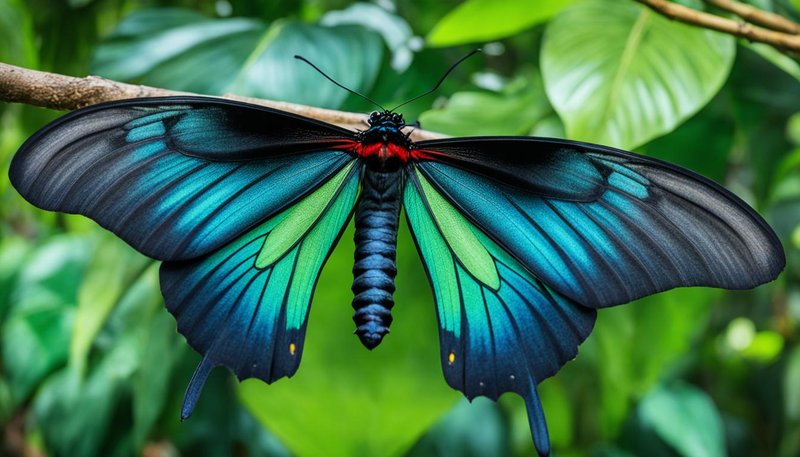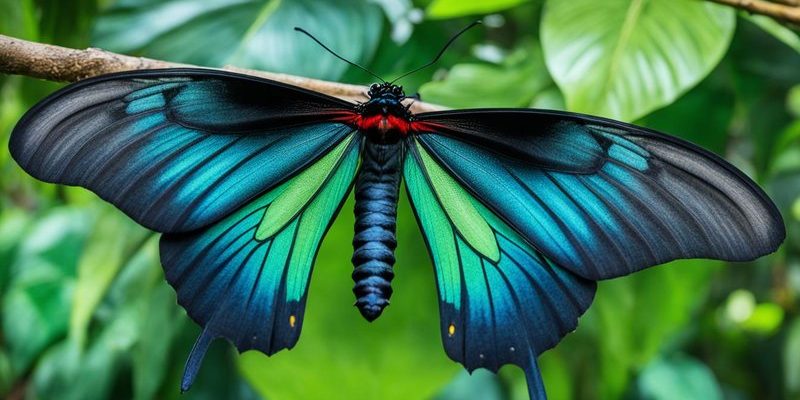
When you think of butterflies, you might picture delicate, colorful creatures fluttering around flowers. But have you heard of the Queen Alexandra’s Birdwing? This stunning butterfly isn’t just beautiful—it’s the largest butterfly in the world! With its vibrant colors and impressive wingspan, it captures the attention of anyone who encounters it.
This butterfly is named after Queen Alexandra of Denmark, and its grandeur is as royal as its name suggests. Found exclusively in Papua New Guinea, the Queen Alexandra’s Birdwing thrives in the lush rainforests of this tropical paradise. Let’s dive deeper into what makes this butterfly so special, from its size and habitat to its diet and life cycle.
Physical Characteristics
The Queen Alexandra’s Birdwing is a sight to behold. Weighing in at about 12 grams and with a wingspan that can reach nearly 11 inches, this butterfly dwarfs many other species. Its wings are a stunning mix of deep blue and green, often showcasing a shimmering effect in the sunlight. The male and female butterflies, while both gorgeous, have distinct differences. Males generally have more vibrant colors, while females tend to be larger and have a more muted palette.
One of the most striking features of the Queen Alexandra’s Birdwing is its unique coloration. The combination of iridescent blue, black, and green isn’t just for show—it plays a significant role in their mating rituals and camouflage. When perched on leaves, their colors can blend seamlessly with the environment, helping them evade predators. It’s as if nature gifted them with a dazzling cloak for both attraction and protection.
Interestingly, the vivid colors of these butterflies are created not only through pigments but also structural features of their wings. Light interacts with the microscopic structures on their wings, creating that breathtaking iridescent effect. This adaptation not only helps them attract mates but also serves as a warning to potential predators about their toxicity.
Habitat and Distribution
You’ll find Queen Alexandra’s Birdwing fluttering in the tropical rainforests of Papua New Guinea, where the climate is warm and humid. These butterflies thrive in areas abundant with flowering plants, which provide them with both nectar and suitable places to lay their eggs. The lush vegetation of their habitat is essential for their survival and growth, making it a fascinating ecosystem to explore.
The rainforest is not just a home for the Queen Alexandra’s Birdwing; it’s a rich environment where countless species coexist. As you wander through these vibrant woods, you can also encounter exotic birds, various insects, and a plethora of flora. Each element plays a crucial role in maintaining the balance of this ecosystem, but the Queen Alexandra’s Birdwing stands out with its majestic presence.
However, this butterfly’s habitat is under threat due to deforestation and climate change. As more forests are cleared for agriculture and urban development, these breathtaking creatures find their homes shrinking. Conservation efforts are vital to protect their habitat and ensure that future generations can witness the beauty of the Queen Alexandra’s Birdwing in its natural environment.
Diet
What do these magnificent butterflies eat? The Queen Alexandra’s Birdwing primarily feeds on the nectar of various flowering plants, but they are particularly fond of the Aristolochia plant, commonly known as birthwort. This relationship is essential, as the larvae of the Queen Alexandra’s Birdwing rely on these plants as their main food source. The nectar provides energy for the adult butterflies, allowing them to thrive and continue their life cycle.
Interestingly, the larvae of this butterfly are also remarkable. When young caterpillars emerge, they are brown and resemble twigs to help them blend into their surroundings. As they mature, they transform into colorful creatures that can intimidate predators with their striking appearance. They feed on the Aristolochia plant, which is toxic to birds and other predators. This toxicity is inherited by the adults, making them less appealing to potential threats. In nature, having a toxic diet can be a real lifesaver!
The feeding habits of the Queen Alexandra’s Birdwing not only sustain them but also play a role in pollination. As these butterflies flit from flower to flower, they help with the reproductive processes of various plants. This interaction highlights the crucial relationship between butterflies and their environment, showcasing how each creature contributes to the health of the ecosystem.
Life Cycle
The life cycle of the Queen Alexandra’s Birdwing is nothing short of fascinating. Like all butterflies, they undergo a complete metamorphosis, which includes four stages: egg, larva (caterpillar), pupa (chrysalis), and adult butterfly. The female lays her eggs on the leaves of the Aristolochia plant, ensuring that the young caterpillars have a ready food source when they hatch. These eggs are tiny, resembling small dots on the leaves.
Once the larvae emerge, they start feeding voraciously on the plant. They grow rapidly, shedding their skins several times as they increase in size. This part of their life cycle can take a couple of weeks, depending on environmental conditions. As they mature, they’ll search for a safe place to undergo the transformation into a chrysalis, where they’ll undergo significant changes.
The pupal stage is a wondrous time. Inside the chrysalis, the caterpillar is reorganizing itself into a butterfly. This stage can last for around two weeks, after which the adult butterfly emerges, ready to take on the world. The emergence is dramatic, as they unfurl their damp wings and allow them to dry before taking flight. This remarkable transformation from a tiny egg to a regal butterfly is a testament to the wonders of nature.
Conservation Status
The majestic Queen Alexandra’s Birdwing, while stunning, faces serious threats to its existence. Due to habitat loss from deforestation and climate change, the population of these butterflies is declining. The destruction of their natural habitats not only impacts their breeding grounds but also reduces the availability of their food sources, making conservation efforts critical.
Protection measures are essential to ensure the survival of the Queen Alexandra’s Birdwing. Conservation organizations are working tirelessly to preserve their habitat and raise awareness about the importance of biodiversity. Initiatives like reforestation and the establishment of protected areas help create safe environments for these butterflies to thrive.
As individuals, we can also contribute to these efforts. Supporting sustainable practices, such as responsible tourism and eco-friendly products, can play a significant role in preserving their habitat. By taking action, we not only help protect this incredible butterfly but also the diverse ecosystems that rely on it.
Interesting Facts
| Wingspan: | Up to 11 inches (28 cm) |
| Weight: | About 12 grams |
| Habitat: | Tropical rainforests of Papua New Guinea |
| Diet: | Nectar from flowers, primarily Aristolochia |
| Lifespan: | Approximately 6 months |
FAQ
What is the Queen Alexandra’s Birdwing’s primary habitat?
The Queen Alexandra’s Birdwing primarily resides in the tropical rainforests of Papua New Guinea. This environment provides the warmth and humidity necessary for their reproduction and feeding. The lush greenery and abundant flowers create an ideal ecosystem for these butterflies to thrive.
How long does the Queen Alexandra’s Birdwing live?
On average, the Queen Alexandra’s Birdwing has a lifespan of about six months. During this time, they undergo several fascinating stages in their life cycle, from egg to caterpillar to chrysalis, and ultimately to adult butterfly. Each stage plays a crucial role in their survival and reproduction.
What do the larvae of the Queen Alexandra’s Birdwing look like?
The larvae, or caterpillars, of the Queen Alexandra’s Birdwing have a unique appearance. When they first hatch, they are brown and resemble twigs, which helps them camouflage against predators. As they grow, they change into more colorful forms that can deter potential threats due to their toxicity from feeding on the Aristolochia plant.
Are Queen Alexandra’s Birdwing butterflies endangered?
Yes, the Queen Alexandra’s Birdwing is considered vulnerable due to habitat loss from deforestation and other environmental pressures. Conservation efforts are underway to protect their habitat and ensure that these magnificent butterflies can continue to thrive in the wild.
How can I help protect the Queen Alexandra’s Birdwing?
You can support conservation efforts by promoting sustainable practices and making eco-friendly choices in your daily life. Being mindful of the products you purchase and supporting organizations focused on habitat preservation can significantly impact the survival of the Queen Alexandra’s Birdwing and other species in their ecosystem.
What role do Queen Alexandra’s Birdwing butterflies play in their ecosystem?
These butterflies are important pollinators in their habitat. As they visit flowers for nectar, they help with the reproductive processes of various plants. This interaction is vital for maintaining the health and balance of the ecosystem where they live, showcasing how interconnected all living things are.
Can you keep Queen Alexandra’s Birdwing butterflies as pets?
Keeping Queen Alexandra’s Birdwing butterflies as pets is not advisable or legal in many areas, especially since they are a protected species. They have specific habitat and dietary needs that are difficult to meet in captivity, and their conservation is best supported through their natural habitats.
What unique features do Queen Alexandra’s Birdwing butterflies have?
The Queen Alexandra’s Birdwing is known for its large wingspan and striking coloration, which includes iridescent blues and greens. Their size and vibrant appearance set them apart from many other butterflies and make them a popular subject of admiration among butterfly enthusiasts and nature lovers alike.
What plants do Queen Alexandra’s Birdwing butterflies prefer?
These butterflies are particularly attracted to the nectar of flowers, especially those from the Aristolochia plant. This plant is crucial for the larvae, providing them with both sustenance and the toxins they need to deter predators. Preserving these plants is vital for the survival of the species.
How can I see Queen Alexandra’s Birdwing butterflies in the wild?
If you’re interested in seeing Queen Alexandra’s Birdwing in their natural habitat, visiting the rainforests of Papua New Guinea is your best bet. Guided eco-tours often highlight local wildlife and provide opportunities to observe these stunning butterflies in flight, contributing to awareness and conservation efforts.
What makes the Queen Alexandra’s Birdwing different from other butterflies?
The Queen Alexandra’s Birdwing stands out primarily due to its size, being the largest butterfly in the world. Additionally, its vibrant colors, life cycle, and unique habitat preferences differentiate it from other butterflies, making it a fascinating subject for research and admiration in the field of entomology.

